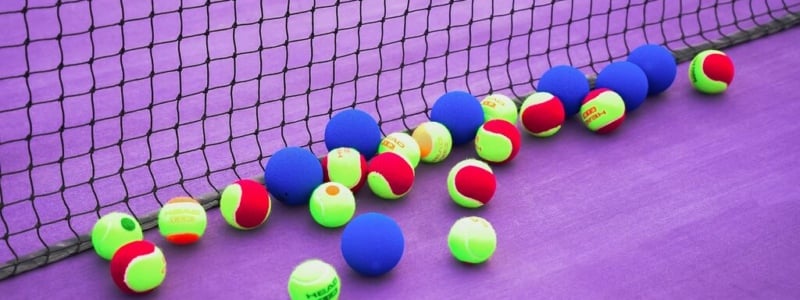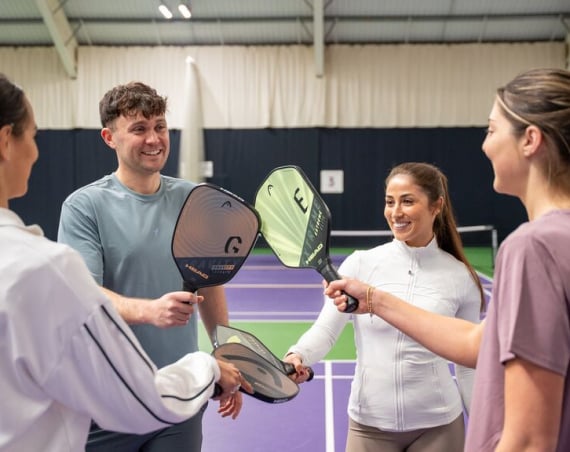While fun and fitness are two simple reasons to spend time on the tennis court, if you’re looking to take things a little more seriously, it could be time to spend time honing and learning new skills. Practice makes perfect if you’re looking to improve your game — and few aspects of tennis demand more practice, repetition and finessing than the serve.
From the basic principles to more advanced techniques, this guide will tell you everything you need to know about serving in tennis, including how to make sure your serve becomes one of the strongest parts of your game rather than a case of hit and hope.
Tennis serve fundamentals
The act of serving is simple enough: The serving player tosses the ball up into the air and hits it to the opposite side of the court. But there’s more to it than that, so let’s start by getting reacquainted with the rules.
- The server must serve diagonally into the service box across the court. He or she must serve from a stationary position behind the baseline, between the centre mark and sideline.
- A missed serve is called a “fault”. Reasons for a fault may include: the server swings and misses the ball; the server begins before the receiver is ready; the serve fails to clear the net; the serve lands outside the service box.
- The server gets two chances to hit a good serve. They may stop the serve by catching the ball and starting over. Serves can be made underhand, but the server cannot bounce the ball before hitting it – the ball must be hit on the volley.
- If a served ball touches the net but lands in, the serve is retaken and this is known as a let.
What does a tennis serve look like?
Although players must serve from a stationary position, it’s a dynamic, explosive movement that requires precision, coordination and plenty of power. Just like any other physical activity, you can quickly learn more advanced tennis techniques by focusing on a small number of important factors.
Start with your grip. Many players, especially beginners, favour a forehand grip because they anticipate hitting the return with a forehand shot. But this grip may limit your ability to swing the racquet along the correct swing path while serving. Try adopting a continental grip, which closely resembles the way you would hold a hammer. It’s much better suited for serves and volleys.
The ball toss may seem like a simple motion, but it’s something even elite players have to work on. Hold the ball with your fingertips and try to keep your wrist neutral and relaxed as you release the ball at around eye level. Your tossing arm should be straight, with all the movement coming from your shoulder.
Ideally, your racquet should make contact with the ball when your arm is fully extended. The exact contact point will vary according to the type of serve — you can hit the ball at the peak of its toss or just after it starts to drop — but the extended arm is a must.
Finally, the leg drive comes into play when it comes to generating power. It’s essentially a case of bending your knees and distributing your weight in a way that harnesses potential explosive energy for your serve. But bending your knees is only half the battle. If you don’t have the right rhythm and flow to your serve, the power generated in your lower body won’t transfer into your serve. This can take years to get right, so don’t worry if you feel out of sync or you’re struggling to tie it all together. Keep practicing and you’ll start to feel more confident and comfortable in knitting everything together.
Vary your serves to enhance your game
Accomplished servers keep their opponents guessing. After you master the basics of the tennis serve, the next step is to add multiple different types of serve to your repertoire to ensure your serves don’t become predictable.
Watch Dylan, tennis coach at David Lloyd Clubs, help us explain how to hit these 3 key serves to include in your repertoire:
Flat serve
Minimal spin is applied to the flat serve, causing it to bounce low and straight from where it lands. This is the stock first serve, being all about speed, power, and a little bit of unpredictability. It’s arguably the best serve to win an instant point with an ace, but it also has a low margin of error and is likely to generate an equally high-powered return from the other side of the court.
Slice serve
Slice serves spin the ball sideways, either away from the opponent to draw them out of position for the following shot or towards their body to make a return shot much trickier. The low bounce that accompanies a slice serve can also make it awkward for the opponent to hit a powerful return, giving you the upper hand.
Kick serve
The kick serve puts plenty of topspin on the ball, causing it to bounce higher than it normally would. This makes it much more challenging for your opponent to hit an accurate or high-powered return. Because the kick serve comfortably clears the net, it’s a popular choice for second serves. However, it also takes plenty of practice to get right — and until that happens, you may simply be giving your opponent a slow serve to return with ease.
Develop your game at David Lloyd Clubs
Sessions with our qualified tennis coaches will not only help you improve your performance but enhance the overall enjoyment and satisfaction you get from the game. They’re also a great way to form new connections with your fellow members.
Start by discovering the top-class racquets facilities at your nearest David Lloyd Club.
Find a club



